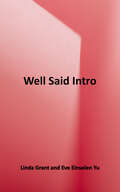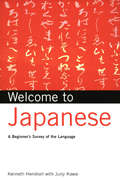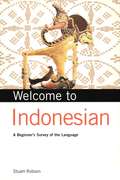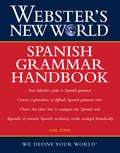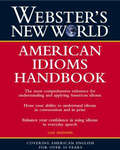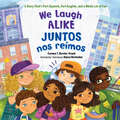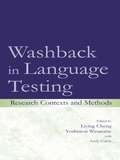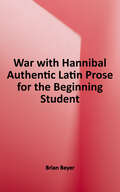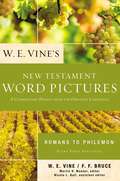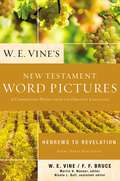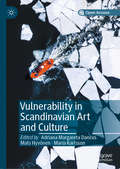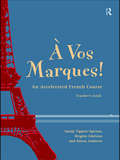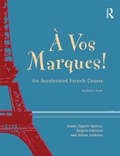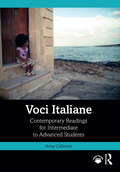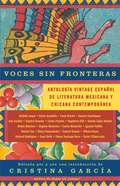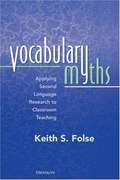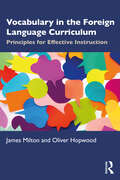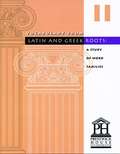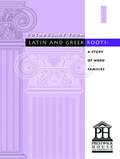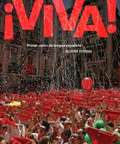- Table View
- List View
Well Said Intro (Well Said, New Edition Series)
by Linda Grant Eve Einselen YuThe Well Said series is designed to improve the pronunciation and communication skills of beginner to advanced students from all language backgrounds. It offers a clear course plan covering the essential areas of pronunciation, including stress, rhythm, and intonation--features that research shows help students the most. Additionally, there are over fifty pages of supplemental activities focusing on consonant and vowel sounds. The Intro level of Well Said is a slower-paced course that introduces the most important pronunciation features at the beginning to low-intermediate level. A free Website for teachers and students includes the full audio program.
Welcome to Japanese: A Beginners Survey of the Language
by Junji Kawai Kenneth G. HenshallThis is a concise and user-friendly introduction to the Japanese language.<P><P>Japanese has too often been treated by Westerners as an exotic curiosity, but the reality is that it is a functional language spoken as a mother tongue by more than 125 million people, and ranks as the ninth most spoken language in the world. In the present global age, an age characterized by a vast range of Japanese products including electronic games and anime, more and more Westerners are in one way or another interacting with Japan and Japanese people. But it is nonetheless fair to say that the language, while increasing in popularity as a subject of study, is still not as widely spoken among non-Japanese as we might expect.In this book we would therefore like to "demistify" Japanese, to show how the language is formed and used, and to encourage you to pursue the study of it. Of course it has its challenges, especially with regards to the writing system, but we try to put these in a balanced context. And we like to think that, by describing the various facets of the Japanese language to you, we thereby empower you with a degree of knowledge and familiarity.
Welcome to Indonesian
by Stuart RobsonThis is a concise and user-friendly introduction to the Indonesian languageThis concise book aims to introduce the reader to the Indonesian language not by creating a course, with grammar and exercises, but by describing it from various points of view, such as telling what it is related to and how it has developed, and on this basis saying where some of its words originate, as a means of familiarization with some common examples. After that, the description moves on to talk about the kinds of words one wold expect to meet, and how they can be put together as sentences, before providing a few examples of journalistic prose as well as some more literary specimens, in order to give a feeling for the language. Welcome to Indonesian includes:Chapter 1: What is Indonesian?Chapter 2: Bahasa Indonesia as the National LanguageChapter 3: A Historical OverviewChapter 4: The Development of Modern IndonesianChapter 5: Indonesian and MalaysianChapter 6: The colloquial Dimension, Influence of Dialek JakartaChapter 7: What is Indonesian Related to?Chapter 9: Loanwords in Indonesian Chapter 10: The Indonesian WordChapter 11: The Indonesian SentenceChapter 12: Journalistic ProseChapter 13: A Literary DimensionSuggestions for Further ReadingGlossary of Indonesian Words
Welcome to Indonesian
by Stuart RobsonThis is a concise and user-friendly introduction to the Indonesian languageThis concise book aims to introduce the reader to the Indonesian language not by creating a course, with grammar and exercises, but by describing it from various points of view, such as telling what it is related to and how it has developed, and on this basis saying where some of its words originate, as a means of familiarization with some common examples. After that, the description moves on to talk about the kinds of words one wold expect to meet, and how they can be put together as sentences, before providing a few examples of journalistic prose as well as some more literary specimens, in order to give a feeling for the language. Welcome to Indonesian includes:Chapter 1: What is Indonesian?Chapter 2: Bahasa Indonesia as the National LanguageChapter 3: A Historical OverviewChapter 4: The Development of Modern IndonesianChapter 5: Indonesian and MalaysianChapter 6: The colloquial Dimension, Influence of Dialek JakartaChapter 7: What is Indonesian Related to?Chapter 9: Loanwords in Indonesian Chapter 10: The Indonesian WordChapter 11: The Indonesian SentenceChapter 12: Journalistic ProseChapter 13: A Literary DimensionSuggestions for Further ReadingGlossary of Indonesian Words
Webster's New World: Spanish Grammar Handbook (Webster's New World)
by Gail SteinThis definitive guide to Spanish grammar covers all aspects of spoken and written Spanish from essential vocabulary to tense and mood conjugations. Webster&’s New World: Spanish Grammer Handbook is an essential resource for any Spanish language learner. Divided into fifteen chapters, it covers everything from basic necessities such as numbers, dates, and weather, to more complex forms of expression such as comparisons, idioms, and the subjunctive mood. Covering vocabulary, conjugation, tenses, moods, and much more, this complete guide will help you hone your Spanish speaking and writing skills. Organized so you can proceed at your own pace and review as needed, Webster's New World Spanish Grammar Handbook helps you progress from vocabulary to proficiency so you can communicate confidently in both social and business situations.
Webster's New World: American Idioms Handbook (Webster's New World)
by Gail BrennerThe most comprehensive reference for understanding and using the contemporary idioms of American English—with more than 1,000 entries. Mastering the use of idiomatic language is an essential step toward achieving fluency in any language. Webster's New World: American Idioms Handbook is the ideal guide to the slang, sayings, expressions, jargon, and colloquialisms of American English—covering more than 1,000 entries. Emphasizing acquisition and application, this book explains their meanings as well as when, where, why, and how to use them. A wealth of examples helps readers understand each idiom&’s connotation and identify its appropriate context. An extensive index allows for quick and easy reference.
We Laugh Alike / Juntos nos reímos: A Story That's Part Spanish, Part English, and a Whole Lot of Fun
by Carmen T. Bernier-GrandSix kids are ready to play: three speak English. Y tres hablan español [and three speak Spanish]. But all of them laugh alike and together! This clever playground adventure weaves together bilingual Spanish and English conversations, so two groups of children can express similar thoughts in their own languages.A brand new barrier-breaking and friendship-affirming bilingual picture book from award-winning author Carmen T. Bernier-Grand (Diego: Bigger than Life). Three kids are playing at the park when three more arrive. The groups can't understand each other because one trio speaks only English and the other only Spanish. But they can express similar thoughts in their own languages. Aquí interactúan el inglés y el español. Can they find a way to play? Of course they can! By watching each other, both groups learn that they are more alike than different and end up discovering new words and making new friends in this adventure propelled by clever integrated Spanish dialogue.
Washback in Language Testing: Research Contexts and Methods
by Liying Cheng Yoshinori Watanabe Andy CurtisWashback refers to the influence of language testing on teaching and learning. This volume, at the important intersection of language testing and teaching practices, presents theoretical, methodological, and practical guidance for current and future washback studies. In the field of language testing, researchers' major interest has traditionally been focused on issues and solving problems inherent in tests in order to increase their reliability and validity. However, the washback effect goes well beyond the test itself to include factors, such as curriculum, teacher and learner behaviors inside and outside the classroom, their perceptions of the test, and how test scores are used. Only recently have researchers started to empirically investigate the phenomenon of washback. This volume of such research serves two essential purposes by:*providing an overview of the complexity of washback and the various contextual factors entangled within testing, teaching, and learning; and *presenting empirical studies from around the world that offer insights into the effects of washback in specific educational contexts and models of research on which future studies can be based. The extensive use of test scores for various educational and social purposes in society nowadays makes the washback effect a high-interest phenomenon in the day-to-day educational activities of teachers, researchers, program coordinators/directors, policymakers, and others in the field of education. Washback in Language Testing: Research Contexts and Methods is a valuable resource for those who are interested in the application of findings to actual teaching and learning situations or conduct washback research in their own contexts, including educational and psychological testing experts, as well as alternative assessment people in all fields, and for policy- and decision-makers in educational and testing organizations.
War With Hannibal: Authentic Latin Prose for the Beginning Student
by Brian BeyerThis edition of Book III of Eutropius's Breviarium ab urbe condita is designed to be a student's first encounter with authentic, unabridged Latin prose. Written in a simple and direct style, the Breviarium covers the period of Roman history that students find the most interesting—the Second Punic War fought against Carthage—and the original Latin text is supplemented with considerable learning support. Full annotations on every page, detailed commentary on grammar and syntax, and a glossary designed specifically for the text allow students to build both their confidence and their reading skills. <p><p>The commentary in the back of the book is cross-referenced to the following commonly used textbooks: <p>• Wheelock's Latin, 6th Edition <p>• Latin: An Intensive Course by Moreland and Fleischer <p>• Ecce Romani II, 3rd Edition - Latin for Americans, Level 2 <p>• Jenney's Second Year Latin <p>• Allen and Greenough's New Latin Grammar <p><p>Macrons have been added to the entire text in accordance with the vowel quantities used in the Oxford Latin Dictionary. Additional resources include an unannotated version of the text for classroom use, supplementary passages in English from other ancient authors, and appendixes with a timeline of events and maps and battle plans. <p><p>The text may be used in secondary schools and colleges as early as the first year of study. The copious translation help, notes, and cross-references also make it ideal for independent learners.
W. E. Vine's New Testament Word Pictures: A Commentary Drawn from the Original Languages
by W. E. VineStudy the meaning of biblical words in the original languages without spending years learning Greek.W. E. Vine's New Testament Word Pictures places every key word from Vine's classic Expository Dictionary of New Testament Words in Bible book and verse-by-verse order. The text of the King James Version of the Bible is included for context, but W. E. Vine's New Testament Word Pictures is keyed to the Strong's numbering system and can be used with any Bible translation.W. E. Vine's New Testament Word Pictures:Explains key words in original Greek contextDoes not require knowledge of GreekIncludes Strong's numbers for further studyIs ideal for busy Bible preachers and teachersCombines the features of a dictionary, concordance, and commentary
W. E. Vine's New Testament Word Pictures: A Commentary Drawn from the Original Languages
by W. E. VineStudy the meaning of biblical words in the original languages without spending years learning Greek. W. E. Vine's New Testament Word Pictures places every key word from Vine's classic Expository Dictionary of New Testament Words in Bible book and verse-by-verse order. The text of the King James Version of the Bible is included for context, but W. E. Vine's New Testament Word Pictures is keyed to the Strong's numbering system and can be used with any Bible translation.W. E. Vine's New Testament Word Pictures:Explains key words in original Greek contextDoes not require knowledge of GreekIncludes Strong's numbers for further studyIs ideal for busy Bible preachers and teachersCombines the features of a dictionary, concordance, and commentary
Vulnerability in Scandinavian Art and Culture
by Mats Hyvönen Adriana Margareta Dancus Maria KarlssonIn this open access book, seventeen scholars discuss how contemporary Scandinavian art and media have become important arenas to articulate and stage various forms of vulnerability in the Scandinavian welfare states. How do discourses of privilege and vulnerability coexist and interact in Scandinavia? How do the Scandinavian countries respond to vulnerability given increased migration? How is vulnerability distributed in terms of margin and centre, normality and deviance? And how can vulnerability be used to move audiences towards each other and accomplish change? We address these questions in an interdisciplinary study that brings examples from celebrated and provocative fiction and documentary films, TV-series, reality TV, art installations, design, literature, graphic art, radio podcasts and campaigns on social media.
Vredaman
by Unai Elorriaga Lopez de LetonaAurreko bere bi liburu arrakastatsuen ondoren (Sprako tranbia eta Van?t Hoffen ilea), nobela berri batekin dator Unai Elorriaga (Algorta, 1973): Vredaman. Aita ospitalean gaixo eta ama hura zaintzen dauzkalako osaba-izekoen etxera bidaltzen duten haurra; golf-klub baten barruan errugbi-zelai klandestino bat margotu nahi duten bi lagun; urtetan arkitekto baten andregai izan baina inoiz ezkondu ez zen emakume adindua; aitite gizon inportantea zela jakin eta haren arrastoaren atzetik dabilen gaztea. Elkarrekin nahasten diren hainbat istorio daude liburu honetan, pertsonaia ameslari, xelebre edo maitagarriz beteak, bakoitza bere estilo eta hizkera berezian kontatua: haurraren sinpletasun magikoa, atso-agureen berritsukeria patxadatsua, alprojen elkarrizketa zoroak? Jolasetik asko du eleberri honek, baina jolasetik harago gizatasun-taupadak ere nabarmenduko ditu irakurleak, amaierara hurbildu ahala emozioan goraka doan kontakizun biribil eta gozagarri honetan.
Vox Latina
by W. Sidney AllenThis is a reissue in paperback of the second edition of Professor Allen's highly successful book on the pronunciation of Latin in Rome in the Golden Age. In the second edition the text of the first edition is reprinted virtually unchanged but is followed by a section of supplementary notes that deal with subsequent developments in the subject. The author also added an appendix on the names of the letters of the Latin alphabet and a select bibliography.
A Vos Marques!: Teacher's Book
by Alison Andrews Brigette Edelston Sandy Tippett-SpirtouThis Teachers' book is designed to accompany the A Vos Marques student's book, an introductory French course designed specifically for false beginners.
A Vos Marques!: An Accelerated French Course: Student's Book
by Alison Andrews Brigette Edelston Sandy Tippett-SpirtouA Vos Marques! is an introductory course for students taking French as an option alongside their main degree course. It has been developed specifically for false beginners: students who have a slight acquaintance with the language.The course comprises a student's book, teacher's book and 180 minutes of audio (available for free download at http://www.routledge.com/books/details/9780415157285/ ) and, through fifteen chapters, follows the progress of an English-speaking student studying in Paris, whose achievements are designed to reflect those of the course user.Special features include:* activities involving pair and group work* an aid to self-assessment at the end of each chapter* hints on vocabulary learning* clear and accessible layout including integrated cartoons.The guidance offered by the teachers book is of particular importance, as lower-level classes in universities are often taught by native-speaking lecturers with little or no teaching training or experience.
Voci Italiane: Contemporary Readings for Intermediate to Advanced Students
by Anna CellineseVoci Italiane: Contemporary Readings for Intermediate to Advanced Students presents intermediate to advanced students of Italian with a series of calibrated and thought-provoking readings from both contemporary Italian fiction and non-fiction. Voci Italiane exposes learners to the authentic language of 21st-century authors whose voices and work reflect and form part of the diverse sociocultural fabric of today’s Italy. The readings expose learners to authentic materials that provoke a reflection on intercultural competence, diversity, and social justice issues and are accompanied by exercises and writing activities. The contemporary and engaging topics covered include gender and race, multiculturalism and plurilingualism, disability, political upheaval, and alternative forms of authorship in art such as graffiti, street art, and underground rap. This book is ideal for intermediate and advanced learners of Italian as a foreign language seeking to expand on their knowledge and understanding of lexical and grammatical structures in Italian, with a focus on 21st-century Italy. It is suitable for use as a primary text for both class-based and independent study.
Voces sin fronteras: Antologia Vintage Espanol de literatura mexicana y chicana contemporánea
by Cristina GarcíaA medida que los descendientes de inmigrantes mexicanos se han ido estableciendo por todo Estados Unidos, ha surgido una gran literatura, pero sus similaridades con la literatura de México han pasado inadvertidas. En Voces sin fronteras, la primera antología que combina la literatura de ambos lados de la frontera méxico-americana, Cristina García nos presenta un diálogo intercultural de una rica diversidad.Voces históricas de maestros mexicanos como Carlos Fuentes, Elena Poniatowska y Juan Rulfo se entrelazan contínuamente con voces magistrales de chicanos como Sandra Cisneros, Rudolfo Anaya y Gloria Anzaldœa para formar una vibrante tela bilingüe y bicultural. El resultado es esta memorable colección de obras de ficción, ensayos y poesía que brinda una perspectiva emocionantemente nueva de nuestro continente --y de la mejor literatura contemporánea.From the Trade Paperback edition.
Voces sin fronteras
by Cristina GarciaA medida que los descendientes de inmigrantes mexicanos se han ido estableciendo por todo Estados Unidos, ha surgido una gran literatura, pero sus similaridades con la literatura de México han pasado inadvertidas. En Voces sin fronteras, la primera antología que combina la literatura de ambos lados de la frontera méxico-americana, Cristina García nos presenta un diálogo intercultural de una rica diversidad. Voces históricas de maestros mexicanos como Carlos Fuentes, Elena Poniatowska y Juan Rulfo se entrelazan contínuamente con voces magistrales de chicanos como Sandra Cisneros, Rudolfo Anaya y Gloria Anzalda para formar una vibrante tela bilingüe y bicultural. El resultado es esta memorable colección de obras de ficción, ensayos y poesía que brinda una perspectiva emocionantemente nueva de nuestro continente y de la mejor literatura contemporánea.
Vocabulary of Soviet Society and Culture: A Selected Guide to Russian Words, Idioms, and Expressions of the Post-Stalin Era, 1953–1991
by Irina H. CortenIrina H. Corten's Vocabulary of Soviet Society and Culture is an experiment in what Soviet scholars call lingvostranovedenie--the study of a country and its culture through the peculiarities of its language. Not a conventional dictionary, Corten's lexicon is selective, offering a broad sampling of culturally significant words in the areas of politics, ideology, the economy, education, arts and letters, social problems and everyday life as well as language associated with the personalities and activities of individual Soviet leaders. The entries are listed alphabetically in English transliteration followed by the Cyrillic, although readers familiar with Russian may prefer to use the Cyrillic alphabet listing included in this volume. In each entry, the author provides a succinct but full explanation of the term and, whenever possible, cross-references to other entries, authentic examples of its use, and samples of relevant Soviet jokes. A reader may approach the lexicon either sequentially or with the aid of a subject thesaurus that divides the material into specific topics. A listing of complementary sources of reference appears in a useful bibliography. With this fascinating lexicon of "Sovietisms," Corten provides an invaluable and easily accessible medium for those general readers and scholars of the Russian language and Soviet culture interested in understanding contemporary Soviet life.Selected entries from the Vocabulary of Soviet Society and CultureAnekdótchik (anekdótchitsa) (cyrillic spelling) (n.)1: A person who tells jokes (anekdoty); 2: coll. since the late Stalin era, a person arrested and given a prison sentence for the telling of political jokes. The phenomenon indicates the important role of the political joke in Soviet culture and, specifically, in the dissident movement. See iazychnik; sident.The following jokes were popular during the Brezhnev era:1. "Comrade Brezhnev, what is your hobby?" "Collecting jokes about myself." "And how many have you collected so far?" "Two and a half labor camps."2. Question: What is a marked-down joke? Answer: A joke which, under Stalin, got you ten years in a labor camp, and now gets you only five.egoístiki (cyrillic) (n.; pl.). Lit., little egotists; coll. since the 1970s referring to headsets worn by music lovers, especially teenage fans of rock music. The idea is that, by wearing headsets, one shuts out the world and becomes indifferent to everything except oneself.zhrál'nia (cyrillic) (n.). Der. zhrat', to gorge, devour (vulg.); coll. since the 1970s denoting an eating establishment with inexpensive and often bad-tasting food. In the late 1980s, the term also has been applied to new fast-food restaurants which have been built in Soviet cities by Western concerns, for example, McDonald's. See amerikanka; stekliashka; stoiachka.
Vocabulary Myths: Applying Second Language Research to Classroom Teaching
by Folse Keith S.In Vocabulary Myths, Keith S. Folse breaks down the teaching of second language vocabulary into eight commonly held myths. In debunking each myth, he introduces the myth with a story based on his 25 years of teaching experience (in the United States and abroad), continues with a presentation of what empirical research has shown on the topic, and finishes with a list of what teachers can do in their classrooms to facilitate true vocabulary acquisition. The goal of Vocabulary Myths is to foster a paradigm shift that correctly views vocabulary as fundamental in any second language learning process and demonstrates that research supports this goal-that in fact there is a wealth of empirical evidence to support these views. In addition, an important theme is that teachers have overestimated how much vocabulary students really understand, and as a result, the so-called "comprehensible input" is neither comprehensible nor input. The second language vocabulary acquisition myths reexamined in this book are: *In learning another language, vocabulary is not as important as grammar or other areas. *Using word lists to learn L2 vocabulary is unproductive. *Presenting new vocabulary in semantic sets facilitates learning. *The use of translations to learn new vocabulary should be discouraged. *Guessing words from context is an excellent strategy for learning L2 vocabulary. *The best vocabulary learners make use of one or two really specific vocabulary learning strategies. *The best dictionary for L2 learners is a monolingual dictionary. *Teachers, textbooks, and curricula cover L2 vocabulary adequately.
Vocabulary in the Foreign Language Curriculum: Principles for Effective Instruction
by James Milton Oliver HopwoodWritten by experts in the field, this book explains the principles of effective vocabulary instruction for the modern language classroom. While many language classrooms rely on practices which can be outdated, idiosyncratic or ill-advised, this book overviews the research and background necessary to successfully integrate vocabulary instruction into the curriculum in a systematic way. Starting with the common gaps in vocabulary instruction, Milton and Hopwood demonstrate how students’ development of a large, communicative lexicon, with an understanding of word structure and collocations, is an essential component of language instruction. The book addresses goal setting, curriculum design, word selection, how words are learned, learning in and outside of the classroom and more. It also addresses common myths about teaching vocabulary in the United Kingdom and around the world. This comprehensive text fills an important gap in the literature and is ideal for undergraduate and postgraduate courses in world language/foreign language methods and language methods courses.
Vocabulary from Latin and Greek Roots: A Study of Word Families, Book 2
by Elizabeth OsborneVocabulary from Latin and Greek Roots shows students how thousands of words share common elements: roots, prefixes, and suffixes derived from Latin and Greek.
Vocabulary from Latin and Greek Roots: A Study of Word Families, Book 1
by Elizabeth Osborne Paul MolikenIn this etymology-based vocabulary program,units are organized by meaning rather than alphabetically and it aims to increase retention of new words as well as to expand students' vocabulary.
¡VIVA! (Second Edition)
by Philip Redwine Donley Jose A. BlancoWelcome to ¡VIVA!, Second Edition! This highly successful introductory Spanish program is designed to provide you with an active and rewarding learning experience. You are about to embark on an exciting adventure as you learn Spanish and explore the diverse cultures of the Spanish-speaking world.New to the Second Edition * Culture! An enhanced Exploración section presents compelling cultural information on the products, practices, and perspectives of the Spanish-speaking world * Readings! Two new readings--a literary piece and a comic--in the Lectura section help you develop your reading skills with authentic material * Technology! A comprehensive upgrade to the ¡VIVA! Supersite (viva.vhlcentral.com); see p. xxx for a complete description * Support! Ancillaries like the Flash cultura video program and MAESTRO® Language Learning System all closely integrated with your student text
